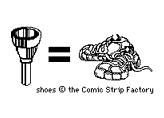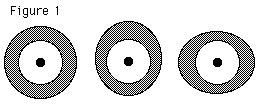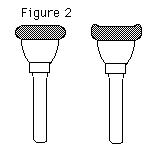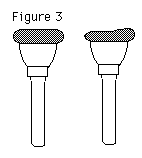Mouthpiece Meditations Part 5
Over its year-long course, this series of articles has examined different aspects of the trombone mouthpiece. It began by exploring what makes a "good" mouthpiece and what a trombonist can reasonably expect from one, continued by detailing how different elements of design contribute to function, presented a method for systematically evaluating different designs, and most recently, discussed what's involved in switching mouthpieces. This final installment will venture into speculative territory by proposing some ideas for future mouthpiece development, after a brief discussion of the current state of the art.
Where It's At
Modern mouthpiece design can be traced to New York City in 1919, when Vincent Bach first began replicating mouthpieces on a lathe to specific plans. Prior to this, mouthpiece fabrication was frequently a haphazard process carried out by machinists following the instructions of musicians acting as designers.1 Bach and contemporaries such as Albert Almont, George Bukur, Rudy Muck, John Parduba, Frank Zottola, and Robert Giardinelli developed mouthpiece designs, still in use today, on the basis of practical experience and in consultation with leading musicians, bringing high levels of craftsmanship to the process. It is difficult to argue with the accomplishments they and their successors have achieved; every day professionals and amateurs alike make music with their products. However, it should be noted that those products are still largely the result of empirical effort and the technology of time past.
What has happened in the field of sports over the same period of time may be illuminative. Like music, sports are pursued by individuals seeking peak performance through innate ability, experience, informed instruction, purposeful practice, and equipment that enhances that performance. In recent years methodical research and new scientific tools have made it possible to get a better grasp on nearly every aspect of sports, through greater understanding of the human body, the physical laws that apply, and the technology that can be applied. Research does not necessarily invalidate empirical information; rather, it places it in a framework where it can be understood and its limits discovered. Compare athletes, their equipment and coaching methods from as recently as 40 years ago to what is available today, and then consider what comparable efforts applied to musicians and their equipment might produce.
"B B & E"
Many scientific disciplines might be applied to mouthpiece theory; three will be discussed here: biometrics, biomechanics, and ergonomics.
Biometrics is systematic measurement of living things. An example would be tissue studies that indicate a runner has muscle fibers better suited to sprinting than endurance racing, or measurements of a swimmer's foot size and shape to correlate it to relative competitive success and effectiveness in the water.
Biomechanics is the analysis of the way living things move, the precise motions and forces involved, and the underlying mechanisms. An example might be computer-aided study of the throwing action of a baseball pitcher's arm so that he could be shown how to throw in a way that allowed maximum controlled use of his strength without tearing muscle ligaments.
Ergonomics is sometimes referred to as human-centered design, creating tools that complement the human body rather than forcing it to conform to tools designed with only the task in mind. An example would be the 'orthopedic' handgrips of modern fencing weapons that make them easier and more comfortable to wield effectively.
If the Shoe Fits...
 It would be odd if the above three interrelated disciplines could not be applied to mouthpiece questions. Measuring feet to determine shoe size is applied biometrics. An installment of this series dealt with the lack of standard measurements for mouthpieces; there is also a lack of standards for measuring trombonists' embouchures. One who has addressed this problem is Henk Rensink of the Netherlands, who has developed a mouthpiece-embouchure sizing/fitting methodology.
It would be odd if the above three interrelated disciplines could not be applied to mouthpiece questions. Measuring feet to determine shoe size is applied biometrics. An installment of this series dealt with the lack of standard measurements for mouthpieces; there is also a lack of standards for measuring trombonists' embouchures. One who has addressed this problem is Henk Rensink of the Netherlands, who has developed a mouthpiece-embouchure sizing/fitting methodology.
According to a brochure describing his services, Rensink begins with a preliminary study of a client's embouchure and a brief playing session, followed by more exacting measurements. Rensink does not favor any single brand of mouthpiece, but instead carries a range "from A(lexander) to Z(ottola)," from piccolo trumpet to bass tuba. Some of the factors he takes into consideration include; mouth posture, lip position, dental characteristics (shape, position, etc.), rim width vs. lip tension, and breathing capacity/stamina. These measurements are used to select mouthpiece(s) best matched to the player and his/her instrument(s) that will then be refined further. According to the brochure, Rensink offers his services to brass players of all skill levels and all styles of music. Rensink has several publications describing his methods but they are not, to the best of my knowledge, currently available in English. This may be why his work has not received greater notice.
In the Brass Embouchure Survey Report which was available on-line until recently, Matt Vaughn cited the work of Maurice Porter who developed four embouchure classifications on the basis of teeth and jaw structure. Vaughn noted that Donald Reinhart goes even further; his "Pivot System" described nine embouchure classifications on the basis of mouthpiece placement, air stream direction into the mouthpiece, and under/over bite. Depending on the classification, Reinhart suggests different embouchure and mouthpiece strategies. In contrast is the work of Philip Farkas which, according to Vaughn, suggests that the player should attempt to maintain a certain 'set' of jaw and lip to create a 'proper' embouchure, rather than creating an embouchure around his/her individual characteristics. Vaughn observes that the two approaches are logical, and that both have been applied successfully, yet they are contradictory.
Biometric analysis might help resolve this issue. Any system of measurements that can consistently match the physical characteristics of a brass player to well-fitting mouthpieces should also be useful in characterizing embouchures. This would make it easier to correlate different techniques for embouchure development with how effective they are with different physical characteristics.
How Does It Work?
Exactly how stretching lips across the rim of a mouthpiece and blowing air between them turns into the sound of a trombone (or any brass instrument for that matter) has long been a subject of investigation. Assorted visualization methods have been attempted over the years, including stroboscopic photographs through specially modified mouthpieces and high-speed movies. More recently video and fiber-optic imaging systems have come into use, as have computer programs which attempt to mathematically model what occurs.
Ellis Wean's transparent "Tru-Vu" mouthpieces are perhaps the most accessible means for players to see for themselves what is happening. His web site has animations of stroboscopic images of embouchures in action on several different mouthpieces.
Wean comments that observing what happens outside the mouthpiece bears little relation to what the embouchure is doing inside, and that visualizer rings do not give the results seen when actually playing with a "Tru-Vu" mouthpiece. As such, Wean claims that many embouchure problems can be resolved through use of a "Tru-Vu" mouthpiece which actually allows the player to see (and hear) what is happening during performance. Matt Vaughn's survey report attempted to get feedback from brass players on a technique he refers to as "shifting, repositioning the mouth on the mouthpiece to deal with extremes of range." It would appear that many of the questions he was addressing could be profitably investigated with "Tru-Vu" mouthpieces.
Another intriguing method of gaining information about how lips and mouthpieces work together was described in the abstract of a presentation given last summer at the International Symposium on Musical Acoustics at the University of Edinburgh, Scotland. Joél Gilbert of the Laboratoire de Mécanique et d'Acoustique, Le Mans, France and Jean-Francois Petiot of the Laboratoire d'Automatique de Nantes, Nantes, France presented a key-note paper giving results of their work with an "artificial mouth" which duplicates the action of lips on a mouthpiece.
The apparatus was developed because it allows precise measurements under controlled circumstances. Although Gilbert and Petiot were exploring abstruse theoretical considerations, some immediate practical applications come to mind. Given an artificial embouchure that can generate realistic trombone sound behavior in a controlled and reproducible manner, such a device might be used to obtain definitive answers about mouthpiece characteristics. For example, how do cup depth and shape affect tonal quality? What effects do changes in bore dimensions produce? Does increased mouthpiece mass actually improve pitch centering? Can air stream be directed in a way that matches what occurs with natural embouchures, and if so, with what results? These are just a few of the questions that might be investigated.
A study that demonstrates there is still much to learn about the way the mouthpiece and the embouchure function is that of Joe Barbanel, John Booth Davies, and Patrick Kenny, reported in New Scientist magazine in 1986. The three set out to discover exactly how much pressure trumpeters apply to their lips when they play. What they found contradicts much of what is still being taught about pressure.
They devised a short piece of brass tubing equipped with transducers that could accurately measure the mechanical force applied to the lips and the orientation of that force, between upper and lower lips. The tube was inserted between the mouthpiece and the trumpet receiver. Aside from the expected tuning adjustments, it allowed trumpeters to play normally. They recruited 30 expert and 30 amateur trumpeters for most of their studies. Measurements made during performances of the same musical passages by each group found that there was no significant statistical difference between the groups and the amount of pressure used; individual variation was more important.
In other words, it was not possible to separate experts from non-experts by how much pressure was applied. Some, especially the experts, used astounding amounts of pressure for high or loud notes. Early models of the apparatus began to collapse under the strain. One measurement found that the force being applied was equivalent to balancing a full sack of potatoes on the lips! The lowest level consistently measured while playing a high C was 30 newtons. (30 newtons is equivalent to 3 kilograms (6.6 pounds)of weight resting on the embouchure.)
A second experiment involved two groups of photo sets. One group consisted of sets of four photos of single players, with one for each of four notes ranging from the bottom to the top of the register. The second group consisted of photos of four different players playing the same note. The researchers had measurements of the force being applied in each photo.
While the expert players could accurately rank increasing amounts of force being used by the same player in four different pictures, they did no better than amateurs in deciding how much force four different players were each using for the same note. The researchers themselves had noted that they sometimes stopped to recalibrate their equipment because they could not believe how much force was being used by players who appeared to playing with almost no effort. The conclusion was that it is impossible to tell simply by looking how much force was being applied.
A third experiment involved asking players directly to estimate how much force they were using, and also asked them to attempt to vary it in relative amounts, i.e.: half as much, and so on. What they found was that neither expert nor non-expert players could accurately judge how much force they were using, especially in the higher registers, nor could they accurately increase or decrease it. While these experiments were performed with trumpets, there is no reason to believe that similar results would not be obtained with trombones. This study suggests that a degree of skepticism should be applied to any theory about the workings of embouchures and mouthpieces that does not have accurate, reproducible data to back it up.
Fitting Form to Function
Mouthpiece design has largely been directed towards two goals: designs that are comfortable for the player, and designs that make it easier for the player to do what s/he wants to do. Because trombonists come in a variety of shapes, sizes, and with various playing demands, there is need for a corresponding range of choices in mouthpieces.
Main-line mouthpiece manufacturers have attempted to fill this need by both offering a varied line of standard designs and also modifying them to customer wishes. Specialists like John Stork and others do a thriving business making, fitting, and customizing mouthpieces for brass players who seek the ideal personalized mouthpiece.
Further refinements in mouthpiece design are available. Douglas Elliott is among those who offer a line of mouthpieces with interchangeable shanks, cups, and rims for players who wish to 'tune' individual components to their needs. David G. Monette has evolved a family of heavyweight mouthpiece and instrument designs on the basis of his convictions about the importance of mass. The Parduba double-cup mouthpiece is another variation on standard design. Dating back to 1935, its patented internal cup shape is supposed to make it easier to play in higher registers. For players seeking the ideal cup depth, Walt Sarad designed the adjustable Multi-Kup mouthpiece. A twist of the cup is all that's needed to select between 13 different depths. Sarad has several styles available, and will manufacture them to customer wishes. Trombonists who are torn between silver-plated brass mouthpieces, gold plating, solid sterling silver, or other metals, have alternatives. The "Tru-Vu" mouthpieces of Ellis Wean are entirely plastic; other makers offer plastic rims for some of their models. Maurice Benterfa offers yet another choice: wooden mouthpieces. Five models are available in four different woods: Ebony, Ziricote, Violet-Wood and Olive-Wood. According to Benterfa, wooden mouthpieces possess a different 'feel' than metal, and have very different timbral qualities.
 While all of the above choices seek to meet the two goals of mouthpiece design--comfort and functionality--there is more that could be done from an ergonomic point of view. It is largely agreed that the rim is the most critical element in fitting a mouthpiece to a trombonist, because that's where the player and the instrument meet. While all of the choices above seek to provide the best match for a player in different ways, mouthpieces all share one characteristic: radial symmetry. This is the ideal situation only for those players who have perfectly symmetrical embouchures--all others must adapt.
While all of the above choices seek to meet the two goals of mouthpiece design--comfort and functionality--there is more that could be done from an ergonomic point of view. It is largely agreed that the rim is the most critical element in fitting a mouthpiece to a trombonist, because that's where the player and the instrument meet. While all of the choices above seek to provide the best match for a player in different ways, mouthpieces all share one characteristic: radial symmetry. This is the ideal situation only for those players who have perfectly symmetrical embouchures--all others must adapt.
Consider some of the possible ways mouthpiece rims might be modified to provide a better fit. Rim width is one. Some players might benefit from a rim which is slightly wider over the center of the top lip or the bottom lip, or both; others might benefit from a rim that is wider over the corners of their embouchure. (Figure 1) It is possible a mouthpiece rim that curves up slightly on either side might provide a better seal for players with greater jaw curvature.  (Figure 2) The angle of the plane of the rim to the axis of the bore might be adjusted too, tilted slightly to accommodate either an overbite or an underbite. (Figure 3)
(Figure 2) The angle of the plane of the rim to the axis of the bore might be adjusted too, tilted slightly to accommodate either an overbite or an underbite. (Figure 3)
None of the above rim modifications need affect the inner rim. It can remain perfectly circular and uniform, though it doesn't have to. It's possible that the rim bite of the inner edge could be varied. Is a sharp edge as important over the lower lip as the upper, or over the corners? The same consideration applies to rim contour: would a rim with differing amounts of roundedness in different regions prove more effective for some players? Given that some players shift their embouchures as they traverse different parts of their range, would a non-circular inner rim be useful? (Figure 4)
Mouthpieces are traditionally radially symmetrical for one simple reason. They're turned on a lathe. The advent of microcomputers capable of designing shapes in three dimensions and driving milling machines to create those shapes means that we no longer need be limited to traditional shapes. Once past the rim, acoustical considerations make symmetry a virtue, but it doesn't mean the rim can't be better fitted to the player so long as there is a smooth transition from the rim to the rest of the mouthpiece.
Of course, there are other considerations. An ergonomic rim would truly have to be a personalized mouthpiece--but a system of biometric measurements for the embouchure as described above would make it easier to create one, once it was determined which rim variations were appropriate for different embouchure variations. Expense is another problem. However, using a system such as that of Elliott's interchangeable components, means all of the custom shaping work could be limited to the rim.
Again, given a system of embouchure measurements, it might be possible to develop a turn-key fitting process, using computer-driven shaping tools. The basic goals of a mouthpiece design are comfort and functionality. An ergonomic rim should certainly aid that, and it might go further.
Using a rim that works more naturally with the player's embouchure should reduce the stresses of playing, which should in turn reduce embouchure injuries and extend playing careers. An article in the Ottawa Citizen by Steve Mazey 5 noted that career considerations and demanding playing schedules often force a player to choose between resting to permit an injury to heal or eating. Any modifications to mouthpieces that can make them less likely to contribute to injury can only be good thing.

Discussion
The proposals offered in this last installment arose out of the initial question that inspired this series. It's impossible to think about what makes a good mouthpiece without thinking about what might make one better. It is to be anticipated that there might be some problems implementing the proposals made here.
It was noted that sports have benefited greatly from the application of science and technology. It should also be noted that literally millions of dollars are at stake in sports today; trombonists and musicians in general don't have those same resources to call on.
To this point I would remark that sports have already paid for much of the original development costs. It should be possible to obtain the attention of the experts, their techniques, and their equipment for quite a bit less than the initial cost.
Another consideration is what is called in the computer industry the "installed base." That is to say, there are a vast number of mouthpieces, musicians, instructors, instructional methods, and manufacturers out there who are perfectly happy with the current state of the art--or at least not miserable enough about it to be inspired to change. This represents staggering institutional inertia. Against this I can offer little, other than to point out that a number of people make a good living with offerings that go beyond the standard fare.
Finally, there is the 'theological' argument, that music is inherently vulnerable to over-analysis, that too much examination can destroy it, and that preoccupation with equipment and theory misses the point. To this I would counter that one should seek as much understanding as possible. Once it is achieved, it becomes possible to focus on everything else with the assurance that the foundation being built upon is solid.
I'd like to offer an additional comment. Perusing the abstracts of the ISMA conference and similar work elsewhere shows that there is a lot of work being done on musical problems at a very fundamental level. What is less apparent is to what extent this knowledge is being applied to practical ends. I'd hope that the proposals offered here could result in some of this research yielding results that working musicians and laymen could take advantage of.
Summary
This concludes my meditations on the mouthpiece. I promised that I might not come up with all the answers, but that I hoped to at least organize the questions. I hope this has answered some of them and given readers an idea of where to look for solutions to those I haven't. In the meantime, I'll be doing what is really important with my mouthpieces: practicing, practicing, and more practicing, with intelligence, purpose, and musicality--or so I hope.
References
Andre M.Smith, "Robert Giardinelli (1914-1996): Four Decades of Excellence in New York," International Trumpet Guild 21, no. 2 (December 1996).
Henk Rensink, Personalised Mouthpieces for Brass Players, Schopenhauerstraat 61, 7323 LS Apeldoorn, Netherlands. Telephone/fax: +31 55 366 88 03.
Joe Barbenel, John Booth Davies, Patrick Kenny, "Science Proves Musical Myths Wrong," New Scientist 1502 (April 3, 1986).
Doug Elliott , Doug Elliott Mouthpieces, 13619 Layhill Road, Silver Spring, Maryland 20906 (301) 871-3535.
Steven Mazey, "Playing Through Pain: Musicians Battle On-Job Injuries", The Ottawa Citizen, 8 November, 1997.
